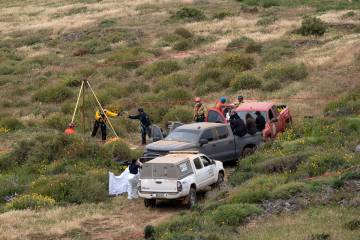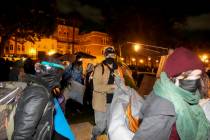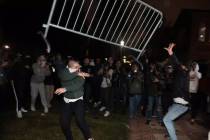Has Queen Nefertiti’s tomb finally been found?
Nefertiti has continued to capture our collective imagination throughout the ages. No trace has been found of the legendary "beautiful one" who ruled across Egypt at her husband's side... until, possibly, now.
Nicholas Reeves, a British archaeologist at the University of Arizona believes he has found her resting place hidden in plain sight -- in the tomb of Tutankhamun.
The bold new theory comes after extensive analysis of high resolution images published online last year by Factum Arte, a Madrid-based art restoration specialist who helped create a facsimile of King Tut's burial chamber in Luxor. In the scans, Reeves spotted cracks in the walls that could indicate two previously unrecognized "ghost" doorways lay behind the walls.
"The implications are extraordinary, for, if digital appearance translates into physical reality, it seems we are now faced not merely with the prospect of a new, Tutankhamun-era storeroom to the west; to the north (there) appears to be signaled a continuation of tomb KV 62 (Tutankhamun's tomb), and within these uncharted depths an earlier royal interment -- that of Nefertiti herself."
Was Nefertiti the tomb's original occupant?
Despite relentless looters, the boy king's tomb remains one of Egypt's most prolific discoveries. Uncovered by Howard Carter in 1922, it remains the most intact tomb ever unearthed. And has been a treasure trove for archaeologists, where close to 2,000 objects were recovered.
In his paper on the possible find, Reeves theorizes that the size of Tutankhamun's tomb is "less than appropriate" for the final resting place of an Egyptian king. Instead he seems to solve the conundrum that has baffled archaeologists for years by explaining that it's inadequate size and layout is because it's an extension of an earlier tomb originally designed for a queen.
The academic also surmises that recycled equipment found in the burial chamber predates Tutankhamun's accession. He concludes the tomb was most likely intended for an Egyptian queen of the late Eighteenth Dynasty -- of which Reeves points out Nefertiti is the only woman to achieve such honors -- and repurposed upon Tutankhamun's untimely death at 17 years old.
"At the time of Nefertiti's burial... there had surely been no intention that Tutankhamun would in due course occupy this same tomb. That thought would not occur until the king's early and unexpected death a decade later," writes Reeves.
While the tomb of the ancient queen has long been thought to be lost, Reeves' theory has got Egyptologists buzzing.
"It's certainly tantalizing what Nicholas Reeves has suggested," says Toby Wilkinson, an Egyptologist at Cambridge University.
"If we look at what we know: we're pretty certain there is an undiscovered royal tomb of roughly the same period somewhere, because we have more kings than we have tombs, so logic suggests that there's still a tomb to be found."
In search of a lost queen
This isn't the first time a new lead has emerged in the hunt for Nefertiti. In 2003, Joann Fletcher from the University of York made waves when she announced that her team had identified an anonymous mummy known as the "Younger Lady" uncovered in a secret chamber inside a tomb in the Valley of the Kings as belonging to the ancient queen.
She cited evidence of the presence of a Nubian wig favored during the Amarna Period (when Nefertiti is thought to have lived), alongside embalming analysis and examination of debris.
The theory -- which aired in a documentary on the Discovery Channel -- was soon disputed by Zahi Hawass, then secretary-general of the Egyptian Supreme Council of Antiquities, who concluded the mummy was actually that of a 15-year-old male.
More questions than answers
Alas, the mystery is likely to continue for a good while yet. The sensitivity of the site and its cramped conditions make examining the tomb in situ especially challenging.
"I think by using modern seismic X-ray technology it should be possible to look through the walls and see if there are significant anomalies or indeed gaps in the bedrock behind those walls," says Wilkinson.
"That sort of ground penetration radar is well developed. It's been used in the Valley of the Kings and other places in Egypt," he says.
Even if this portal is found to exist and leads to a hidden chamber inside Tut's tomb, Wilkinson maintains such a discovery would lead to an even longer debate about how best to excavate the site without causing damage to the existing tomb.
"We may get to the point within a few years of knowing whether there is a chamber behind (those walls), but I think it will be quite a while before we can peek inside any chamber that might be there," he says.
"But it's very tantalizing and it would be nice to think that in a few years' time we might have the final answer."
Sophie Eastaugh contributed to this story.




























